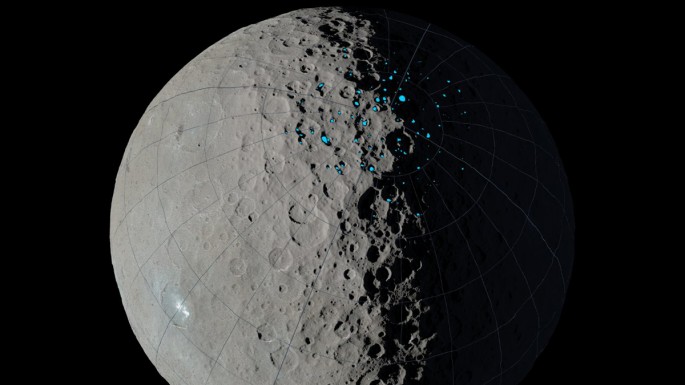NASA's Dawn spacecraft recently detected mysterious bright spots made of salt on dwarf planet Ceres located in the main asteroid belt Mars and Jupiter. Now, astronomers have identified darker regions on Ceres that actually serve as water ice deposits.
Scientists also reveal that there are regions of Ceres that are located under a permanent shadow, where it is initially thought that this region is frozen enough that it can trap water ice for a period lasting billions of years.
According to Dawn mission scientist Norbert Schorghofer from the University of Hawaii, apparently, the current conditions on Ceres are ideal for water ice accumulation that can lead to vast amounts of ice deposits. Ceres also possesses enough mass that can retain enough water molecules especially in permanently shadowed regions that can become extremely frigid, colder than the moon or Mercury.
These dark, frozen regions of the dwarf planet are believed to be completely hidden away from sunlight, as they are mostly found on crater floors or hidden parts of the craters. NASA scientists also believe that temperatures can reach well below negative 240 degrees Fahrenheit, which can develop into suitable areas for depositing water ice for years. Scientists call these areas as "cold traps" which also mark the first time that they have been identified in the solar system.
In this new study, images taken from the northern hemisphere of Ceres, more specifically the illuminated areas, were combined to created a 3D model of the dwarf planet. This model also revealed numerous permanently shadowed regions where the largest one is located inside a crater measuring 10 miles across, some 40 miles away from its north pole.
New findings revealed a total of 695 square miles of permanently shadowed regions, that are less than one percent of the entire surface are of the northern hemisphere of Ceres. Researchers also added that these cold traps on Ceres are often found in low altitudes such as polar regions. For example, regions like these on the moon and Mercury that are permanently shadowed are really close to the poles, that can become cold enough for ice to form in very stable conditions.



























